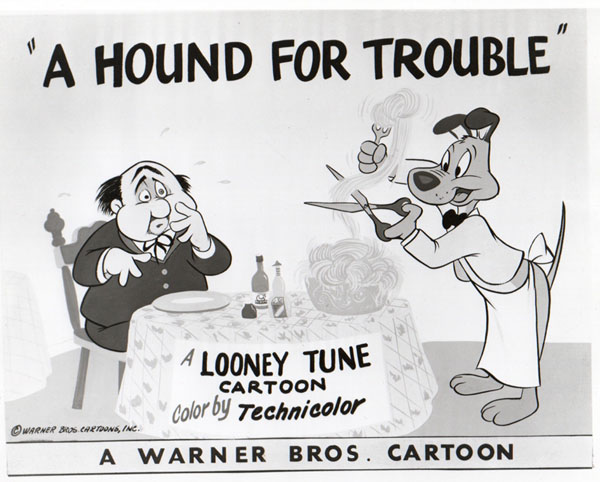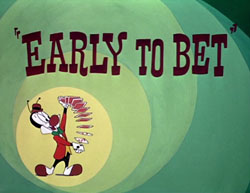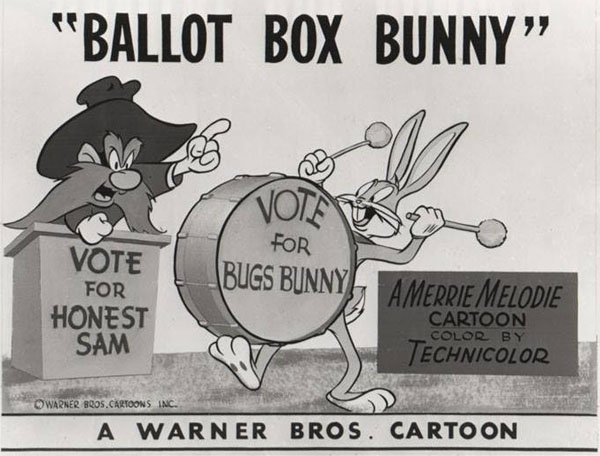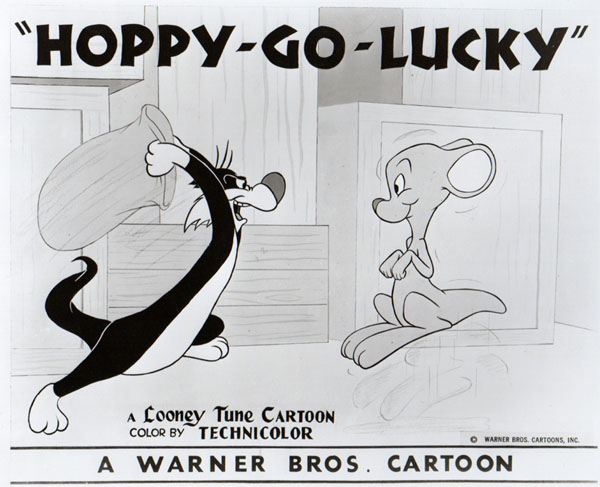Continuing along into the prolific early 50’s of Termite Terrace output. By this time, a certain ex-band vocalist from the Les Brown aggregation had rather taken the world by storm, zooming to the top box office of Warner when it came to musical productions. Doris Day pictures were instant bonanza for the studio, and the cartoon unit was quick to rise to the occasion to plug musical compositions from the product wherever possible. Coincidentally, however, a decision to place Doris in several “period pieces”, giving her the opportunity to revive a bouquet of old-time evergreens, proved to fit the tastes and tendencies of Carl Stalling like a pair of orthopaedic shoes, allowing him to similarly wade down Memory Lane to dig up several forgotten chestnuts of the past for first-time use in the cartoon unit’s productions.

A Hound For Trouble (4/28/51) – Charlie Dog invades Italy, and the peace and quiet of a restaurant proprietor to turn his life upside down with Charlie’s demands that he be Charlie’s “master”. Charlie even insists the restaurant needs a floor show, and performs an original piece of accented “doggerel”, “Atsa Matter For You”. The restaurant owner appears to concede, offering to take Charlie home, but intentionally passes the Tower of Pisa. He feigns a reaction of terror, that the tower is going to fall on his little house, and leaves Charlie to “hold it up” while he runs for help. In reality, the happy proprietor returns to the peace and quiet of his restaurant, while Charlie spends the entire night calling for help to a town that turns him a deaf ear, and wonders why nobody will “Capisce”. “Atsa Matter” would appear again while Bugs prepares his “Wild Turkey Surprise” for the Tasmanian Devil in “Bill of Hare”. “My Buddy”, and “Santa Lucia” also appear.
 Early to Bet (5/13/51) – A study of the habits and habitat of the “Gambling Bug” – an insect who’s bite transmits “gambling fever” to his victim. Among other hopeless gamblers, the bug concentrates on a cat who attempts to avoid a bulldog’s sadistic game of “penalties” – each loss resulting in a card-indexed numbered choice of ghastly tortures. But the bug puts the bite on the cat again and again, until even the dog decides he should “quit before you kill yourself”. The bug substitutes as new contestant in a cut for high card – and himself suffers the “penalty” of “the Post” – being swatted at with intent to squash by the cat with a copy of the Saturday Evening Post. Songs: “Lucky Day” – originated in George White’s Scandals of 1926, and later to become associated with recurring uses in the commercials of Lucky Strike cigarettes. Vintage recordings included George Olsen on Victor, a vocal rendition by the Revelers also on Victor, and Howard Lanin on Columbia (below). Harry Richman vocally performed it on Vocalion. Layton and Johnstone, two American black performers who recorded in England, covered the song for Columbia in Britain. (Layton, by the way, was one of the writers of “After You’ve Gone”.) The film also offers a return for the B-theme of “Powerhouse” to accompany the actions of the bulldog, “Blues in the Night” whenever the cat selects a penalty from the files, and “Frat” whenever the cat receives the Gambling Bug’s bite (likely associated with a new lyric recently recorded by Kay Kyser on Columbia, “Horses Don’t Bet On People”).
Early to Bet (5/13/51) – A study of the habits and habitat of the “Gambling Bug” – an insect who’s bite transmits “gambling fever” to his victim. Among other hopeless gamblers, the bug concentrates on a cat who attempts to avoid a bulldog’s sadistic game of “penalties” – each loss resulting in a card-indexed numbered choice of ghastly tortures. But the bug puts the bite on the cat again and again, until even the dog decides he should “quit before you kill yourself”. The bug substitutes as new contestant in a cut for high card – and himself suffers the “penalty” of “the Post” – being swatted at with intent to squash by the cat with a copy of the Saturday Evening Post. Songs: “Lucky Day” – originated in George White’s Scandals of 1926, and later to become associated with recurring uses in the commercials of Lucky Strike cigarettes. Vintage recordings included George Olsen on Victor, a vocal rendition by the Revelers also on Victor, and Howard Lanin on Columbia (below). Harry Richman vocally performed it on Vocalion. Layton and Johnstone, two American black performers who recorded in England, covered the song for Columbia in Britain. (Layton, by the way, was one of the writers of “After You’ve Gone”.) The film also offers a return for the B-theme of “Powerhouse” to accompany the actions of the bulldog, “Blues in the Night” whenever the cat selects a penalty from the files, and “Frat” whenever the cat receives the Gambling Bug’s bite (likely associated with a new lyric recently recorded by Kay Kyser on Columbia, “Horses Don’t Bet On People”).
Room and Bird (6/2/51) – Granny is trying to sneak Tweety into a hotel with a “no pets” policy – as is Sylvester’s owner as well. Sylvester has purely culinary motives as usual at hearing the crooning of his feathered next-door-neighbor, and writes him as a “secret admirer”. However, most of the tenants of the hotel have similar ideas about getting their pets within, and Hector the bulldog turns out to be another occupant. The three-way chase bounds through the corridors, until the house detective can’t possibly miss that someone’s breaking the rules. He makes a loudspeaker call through the corridors for all pets to be put out immediately – and is trampled by a surprise stampede of every species imaginable – which Tweety attempts to verbally inventory for the final iris out. New number for the film is “Fiddle Dee Dee”, introduced in Doris Day’s It’s a Great Feeling, co-starring Dennis Morgan and Jack Carson. Oddly, no Columbia issue seems to have been released. It was recorded by Sammy Kaye on Victor, and Guy Lombardo on Decca. “Every Little Movement”also makes a reappearance.

Ballot Box Bunny (10/6/51) – Sam’s running for mayor, on a campaign to rid the town of every last rabbit. This does not sit well with Bugs, who decides to oppose Sam in the mayoral election. Sam tries various lethal tricks to rid himself of the opposition – all of which backfire – until the election results give a victory to a “dark horse”. Bugs and Sam engage in a mutual game of Russian Roulette to deal with their disappointment, but Bugs “misses”, leaving Yosemite the worse for gunpowder wear. From the files of Doris Day arises “King Chanticleer”, written about 1908, about a legendary rooster who ushers in the new day. The number had seen recent revival by Doris in By the Light of the Silvery Moon, and this time, Doris would get to have a commercial issuie of the piece on Columbia Records. Superb rival instrumental versions more concurrent with the song’s introduction were recorded by Arthur Pryor on Victor and Prince’s Band on Columbia – each has their own unique strengths, making the definitive version hard to decide. An English recording in the 40’s was also issued instrumentally by the International Novelty Quartet on Regal Zonophone in England. The film also reprises the Private Snafu “Those Endearing Young Charms” piano gag.
Drip Along Daffy (11/17/51) – Western Hero Daffy Duck, accompaned by Comic Relief Porky Pig, decides to “clean up” a lawless Western town (where the most prosperous business is the multi-story complex of a smiling undertaker). Daffy confronts local tough guy Nasty Canasta (rustler, bandit, and square dance caller) in a drinking challenge at the saloon (rivaling a similar contest between Woody Woodpecker and Buzz Buzzard in Wild and Woody), then takes to the street for a showdown. Porky saves Daffy from a bullet with a wind-up toy soldier with well-loaded musket, and becomes the new sheriff, leaving Daffy to “clean up the one horse town” as a Dept. of Sanitation street sweeper. Returning song favorites here include “King Chanticleer” and “The Toy Trumpet”. An original song is featured in the opening sequence, performed by Porky Pig – “The Flower of Gower Gulch” (reference to a sort of shanty town of old movie sets, previously featured in a sequence of Warner’s feature, Thank Your Lucky Stars. To this day, a small shopping center still exists at Gower Street and Sunset Blvd, in Hollywood, that is referred to as “Gower Gulch”.)
Since we can’t access or embed any musical clips from the cartoon itself, we turn to our friend Megan Lynch – who has a wonderful CD of Songs The Brothers Warner Taught Me, which we highly recommend:
Cracked Quack (7/5/52) – Daffy is still tyring to find a cushy alternative to flying south for the winter. He sees a stuffed duck on Porky’s mantlepiece, and thinks, “There’s one of our boys who’s got this flying South for the winter business beat.” While Porky spends the entire picture trying to do his income taxes, his watchful dog provides troubled as Daffy substitutes in place of the stuffed trophy. Song: “Down In Nashville, Tennessee” is heard over the opening titles, recorded by Dinah Shore and Tex Beneke, respectively (both versions on RCA Victor), and by Mark Kenney and his orchestra on Doninion Records of Canada. His was a band popular in the bigger cities of the Prairie Provinces, auch as Alberta, Manitoba, and Saskatchewan, Returning tunes include “Charleston”.

Hoppy Go Lucky (8/2/52) – Robert McKimson’s version of a George and Junior cartoon, with a dum-dum huge cat accompanying Sylvester on the docks (and insisting on calling him “George”) in search of mice. The usual appearance of Hippity Hopper provides the expected consequences. The “Of Mice and Men” spoofing would be later reprised by McKimson without Sylvester in a subsequent season’s inauguration of a primordial version of Speedy Gonzales in Cat-Tails For Two. Songs: “I Cover the Waterfront”, a 1933 song inspired by a book of the same title made into a picture that year, about a reporter covering a waterfront beat. The song became a standard, especially beloved of jazz musicians. When new, it was recorded by Eddy Duchin on Victor, and Joe Haymes on Columbia. A notable concert performance of it appears from the period by Louis Armstrong in a film clip live from Copenhagen. It was later revived by Artie Shaw on Victor, Billie Holiday on Commodore and Columbia, the Ink Spots on Decca, Johnny Green (one of the song’s writers) on Decca, Eddie Heywood on Commodore, and a trio of Don Byaz, Mary Lou Williams, and Specs Powell which appeared on Polydor. The tune became another go-to cue for Stalling for any scene around the docks.
Tree For Two (10/4/52) – An escaped black panther causes unusual trouble for the cat- chasing duo of Spike and Chester (a bulldog and frisky pup), as the panther’s appearances run interference during their pursuit of Sylvester, regularly providing unexplained maulings to the bulldog which make the pup lose all respect for him at being beaten up by a “cat”. Songs: “Love, Ya”, a number featured at least twice in Stalling scores (sung by Granny in a later Tweety episode), originated in another Doris Day feature, On Moonlight Bay (below), and appearing on Columbia by her in duet with Jack Smith. “The Bowery” is heard in hey presto tempo whenever Spike and Chester appear on the scene, and “Charleston” is sung by Sylvester (until he forgets the lyric upon the sight of the dogs).
Onward for more 50’s fun next time.


 James Parten has overcome a congenital visual disability to be acknowledged as an expert on the early history of recorded sound. He has a Broadcasting Certificate (Radio Option) from Los Angeles Valley College, class of 1999. He has also been a fan of animated cartoons since childhood.
James Parten has overcome a congenital visual disability to be acknowledged as an expert on the early history of recorded sound. He has a Broadcasting Certificate (Radio Option) from Los Angeles Valley College, class of 1999. He has also been a fan of animated cartoons since childhood.











































“Room and Bird” was one of the five cartoons scored by Eugene Poddany while Carl Stalling was out undergoing and then recovering from surgery. It’s to Poddany’s credit that you really have to listen hard to notice any real differences between his scores and the ones Stalling had been doing, as compared to the immediately noticeable decline in quality when the John Seely stock music scores were used or when William Lave replaced Milt Franklyn (and Poddany having Franklyn during the orchestrations here may have helped with the cartoons’ musical continuity).
“Room and Bird” also features the song “I’m a Tweet Wittle Bird in a Dilded Cage”, with lyrics by Tedd Pierce, which Tweety had previously sung in “All A Bir-r-r-d” a year earlier. Curiously, both Pierce and Warren Foster are credited with writing “Room and Bird”; I suspect that this was simply to acknowledge Pierce’s song lyrics. It would have been very unusual for the two of them to collaborate on a cartoon.
“Room and Bird” was the first of five cartoon scores composed in 1951 by Eugene Poddany, who filled in while Carl Stalling was recovering from a head injury. I know that Robert McKimson and Mel Blanc both suffered brain trauma in car accidents; did that also happen to Stalling?
Hard to believe “Lucky Day” wasn’t used until 1951 in Looney Tunes cartoons- it was a natural fit. That’s one of my favorite cues, especially its use in the climax of Hare Trimmed.
“O Nene” by Erich Wolfgang Korngold also plays in “A Hound for Trouble”; it’s also heard under the opening titles for “The Cat’s Bah”: https://www.youtube.com/watch?v=Kau3xNuUOSk
Drip Along Daffy used a lot of cues, so many that I’ll just link to imdb: https://www.imdb.com/title/tt0043479/soundtrack . Notably, it was the final use of “San Antonio” by Egbert van Alstyne in a Looney Tunes cartoon- it was used a handul of times before that: https://www.youtube.com/watch?v=JKbpM1SGga0
Room and Bird was one of a handful of cartoons where Eugene Poddany stepped in to compose while Carl Stalling was recovering from a head injury. For the most part, his work is indistinguishable from Stalling’s, though I suspect a large part of that is Milt Franklyn orchestrating his compositions.
Heh, I see great minds think alike with the Room and Bird trivia!
The tune used for “Atsa Matter For You“ is a close variation of the classic Tarantella Napoletana, so close the lyrics fit exactly.
https://youtu.be/4nduIxmHUI8
Fun post. Neat info. Thanks.
As J Lee noted, Eugene Poddany’s 1951 WB cartoons scores approximate Stalling’s very closely in terms of style, unlike those of Seely and Lava, which make one grimace and wonder if somebody dubbed the wrong soundtrack by mistake. After watching “Room and Bird” again, I think the main difference — and it’s still only very subtle — is that Poddany’s music has a more intricate sense of counterpoint than Stalling’s. Unlike Stalling, Poddany studied composition formally, with Mario Castelnuovo-Tedesco (who also taught John Williams) and Ernst Toch, a major modernist composer in Vienna who fled the Anschluss and became a film composer in Hollywood, specialising in stock music for chase sequences. (Toch’s Divertimento, Op. 37, No. 2 [1926], is one of the great 20th-century duos for violin and viola — and one of the most difficult!)
Poddany was Stalling’s copyist, a job that modern music notation software has thankfully rendered obsolete. He had the tedious task of writing out every individual orchestral part from Franklyn’s orchestration. I used to do it occasionally as a freelancer when I was younger. It was hard work, paid poorly, gave you horrible writer’s cramp, and no matter how meticulous your manuscript was, the musicians still complained that they couldn’t read it. But the experience would have given Poddany an intimate familiarity with Stalling’s compositional technique.
Poddany’s last cartoon score was for “Horton Hears a Who” in 1970. He suffered from mental illness later in life and committed suicide in 1984.
Of the five Poddany scores, I feel like The Wearing of the Grin was the one that sounded the least like Stalling, especially during the nightmare sequence.
I didn’t know he committed suicide. That’s a shame.
Read this post:
https://tralfaz.blogspot.com/2019/08/the-troubled-composer.html
Yowp